summer seasonal ingredients.
Decoration in the early summer
May
●The beginning of the summer new tea is fragrant
May 2 is "Hachijuhachiya". We hit eighty-eight day, counting from the first day of spring. As a long time there is a season word called "farewell frost of Hachijuhachiya", which thereafter there is no frost, it has been a time when farming and tea picking begins. And "summer approaches Hachijuhachiya", sang at an early age, "Cha tsumi uta" will be remembered fondly.
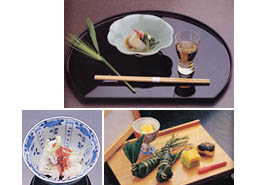
The seal put this new tea in the pot, will be rich and mellow scent and is aged until the autumn. Attract its leaves in the mortar, is brewed tea, it will celebrate its customers. The event to use this new tea, says the "tea ceremony of start broaching". Even the new wine is Kuradashi in Nada and Fushimi of the wine cellar, is just this time. When the temperature is higher, also it comes out lively fish market. Goods also becomes rich, and to circulate also Hatsugatsuo. In particular, white meat of the fish will be delicious.
Sea bream, Dongfeng, such as the restoration is famous. And roasted the Anaime, if Soere the plum meat, season is finished rich toward Supplementary. And, bamboo shoots and broad beans in it is this time of year is in season, you become tasty.
●tofu grilled Stone
This month we will introduce the bowl called "stone baked tofu".
The first, cotton tofu and cut thin to polish the surface. Cut it to four, with a burner, you put a carefully browned while with the change of light and shade. From in the hot water vent, boiled over low heat in a little dark eyes of juice, it soaked the taste.
Then, five, to prepare a six-momme of shrimp, take a head, peeled, takes a back cotton in the Sebiraki. Two or three places, pretend Lightly Salted put the knife eyes, it is familiar is a salt, and the kudzu strike so as not to run away the taste of the shrimp.
ChiShato, Udo, carrots peeled and trimmed to short. This is a long time ago, at the time of the Boys, decorated with red, white, and likened to green Hishi Mochi.
Bluing is vine vegetables, mouthpiece flowers citron. The flower yuzu is a bud of citron flowers. Cracked and press lightly with a finger, subtle fragrance will soar. Juice is, it is a good idea Sumashijiru since it hilarious also.
June
●Seasonal restaurant also reinvented
Tokyo is often the day of rain, followed by annoying day. June Speaking reinvented. Even our waitress is a reinvented the pale color of the kimono in plain, I try to pick up anew your feelings.
This month of flowers forehead "Gaku-azisai(hydrangea)". Since it is a common flower of sober atmosphere compared to the hydrangea, it goes well with Japanese house. Other Fuji, Japanese iris, there are remnants of Iris.
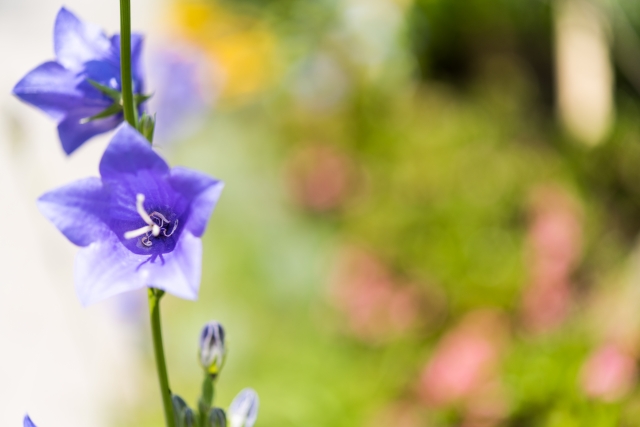
Since these flowers are often depicted in the hanging scroll and framed, or so as not to overlap, it takes care to where to place the flowers input.
In the flower bellflower, it will begin to bloom last seed-sowing day and lovely Bellflower,. If let them to the dragon flower input, it reflected on the more coolness likely.
June will be from one day to the Ayu is lifting of the ban, Itokenaayu, it rests on the menu of the restaurant as Wakaayu. This time of year, you also will often use a white fish in a pottery in sashimi. Vessel also shallow bottom, is more of what little pattern in blue and white porcelain, Serve dishes looks better well in cool. Winter is using the thick of the bowl which is warm there is also extra insulation to the eye, but will use the thin of things little by little bowl from around June.
●Delicious from early summer "Sawani-wan"
Because it is time there is no appetite, this month was to bowl a little Kikaseta spices.
First Sawa Niwan. Sawa Niwan is, in the bowl using the fat and vegetables of the pig, but has been thought to those of the barbarian brought over, as preserved food when the fishermen originally came to fishing, to the juice use the salted meat and vegetables it is said that was born from the place was.
Let's will briefly introduce how to make.
Cut thin the fat pig that shook pre-thin salt, boiled lightly in the broth, and set it aside to moisture. To bowl soup of kelp and dried bonito, Udo you boiled, bamboo shoots, mushrooms, pig fat, put in the order of Sasagaki BoGo, When the bowl juice is boiled, in addition a few drops of sweet sake, put a trefoil. And put the pepper not forget at the end.
Importantly, when floated in a bowl, and cut thin to the same dimensions the ingredients so that it looks beautiful, it is to bring boiled quickly. This is that the fat of the pig also finished per light mouth.
This Sawa Niwan is, to autumn from early summer has been said is a delicious, but also many shops that you are famous put in all year round menu.
Located in the Ginza chome "Samurai Kimu" is famous. The second generation of the husband, and ask to talk to Takaida Keiichi, except a small one time of the year from the father of the generation, It is said that out of the swamp Niwan. Our common customers, had been evaluated as "Sawa Niwan of Hyoe Kimu is a taste that does not change at all with the old days." As well as satisfied with the specialty, it is not to re-confirm that an alive and well in the store.
sited from "Irodori vol.24"
Katsumi Beppu,Representative of Takehatei
Ayu(Japanese trout)
Ayu Is a mountain of food? Some will readers wonder.
Ayu is a river fish of champions that live in the river valleys and canyons, we Japanese people have a great deal of fondness to Ayu. The Westerners, you might not know a bland taste of Ayu of just baked in salt.
The ayu there is a natural and cultured, but let me explain the difference. First appearance. natural ayu is thin and at the adipose fin has a pink color. Aquaculture ayu is fat, color is also dark. Natural ayu look is also slightly different, you feel like he knows the nature of the severity.
However, It is obvious if you look at the price. Natural sticks wholesale price of more than three times that of farming in a small size. By the way farming per 1kg whereas a thousand two hundred yen, natural medium is the remarkable difference that thirteen thousand yen, will be large and 20,000 yen.
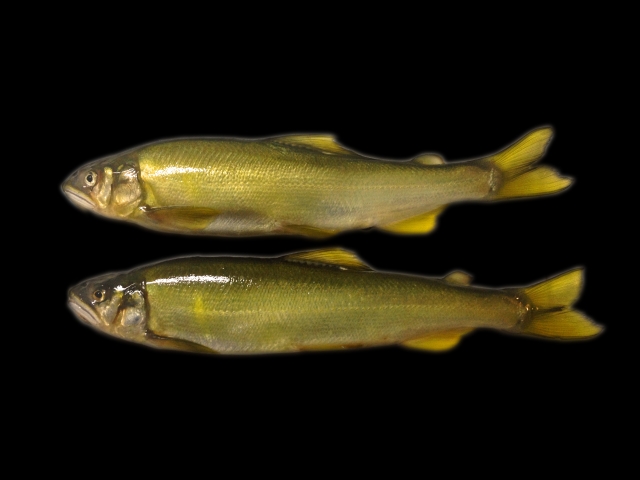 sited from "Irodori vol.07"
sited from "Irodori vol.07"Hirokazu Izui,Representative of Takehatei
Ayu is the most delicious when caught freshly. In addition to simple, is the most delicious way to eat is to burn with the only salt.
Natural ayu is said to "香魁Emeans good smell fish)", it emits a very good smell. The secret of this fragrance is because they eat algae that Ayu is attached to the stone of the river. That Ayu is the Chlorella diet. Farmed ayu smell is not at all.
In the Nagara River in Gifu Prefecture is a famous place of Ayu, the stone of about soccer ball have lying around a lot in the riverbed. I once tried to eat the algae of this stone, but it was only the smell. But I treasure trove of food for the ayu. The marked with algae in stone, you eat so as to the body next to whittle away at the side of the lips. River shines for at this moment, I belly of ayu that lying is glowing.
Ayu is a fish that would die in the easiest among the fish, is very vulnerable fish. Wholesale in the most high the case for fishing with decoys, then those that have been caught in the net, and those caught will be cheapest in Ukai. Ukai of the events of the Nagara River, this historic Ayu fishing method with a history of a thousand two hundred years. Beak of cormorants has rounded carved in such file, but will be scratched when adding absolutely, we wholesale price will be cheaper.
Since the natural ayu can not be supplied to Japan, not to rely on farmed ayu. Ayu has been farmed in seedling center in five locations across the country, but since trading is a weight unit, will become really fat Ayu. Ayu is so eat plenty of food when the water temperature rises.
So the water temperature below fifteen degrees, two to three days before shipment and to the fasting, is called can virile Fit Ayu.
However good aroma is not attached at all. Natural ayu or the appearance building, or in dried overnight and porridge, there are many variations. However, in Gifu Prefecture of authentic, simple ultimate grilled it has become a dogma is that the most, is I also totally agree.
Hamo(Pike Conger)
Protagonist of the ingredients that are essential to the Gion Festival is a big event in Kyoto is Hamo. There is no fish shop that does not put the pike eel in Nishikikoji of the market is said to be in Kyoto of the kitchen. Housewives will continue to always buy Hamo. Tells the coming of summer in Kyoto, it is work of Hamo to liven up the Gion Festival more.
Etymology of Hamo is "食�E" (means eating). Hamo is a ferocious fish bite anything. This strength has been the depth of flavor of the reason. In addition, even if out life force from the strong water is alive for a long time.
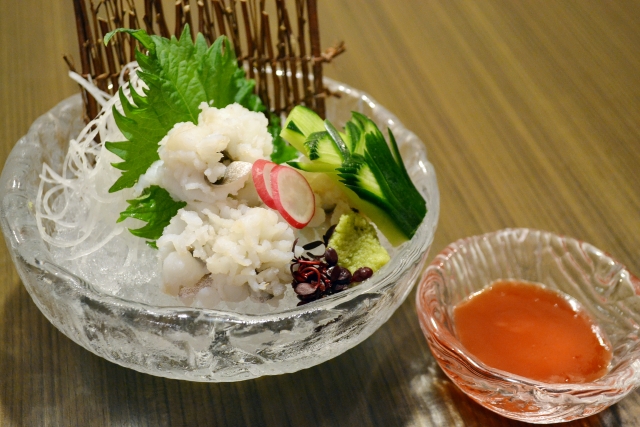 sited from "Irodori vol.41"
sited from "Irodori vol.41"
In the old days, to see that Hamo on the way to carry on Kyoto is still alive even jumped out of the basket, is so people were saying, "Kyoto Hamo is caught in the mountains."
Cook of Kansai, does not qualify as a full-fledged and can not cook the Hamo. That the desert a myriad of small bones called "Hamo cut", "bone cutting". Large and heavy special kitchen knife, we will fully leave a single skin while playing a note in one millimeter spacing. The Hamo is not established in the Kanto is fed up the osteotomy, the short Kanto people of mind there is a theory that because it is not suited.
Hamo are those baked with a sauce like a grilled eel, pike eel sushi, soup, such as cut burnished, it has been established in the Kansai region in a variety of variations. In particular cut burnished of Hamo through hot water, beautifully as if it were white peony, it is very delicious to eat this with plum meat and vinegar.
Unagi(Eel)
Aquaculture eel, fish farms in I think in a lot of people who think that's what fry was artificial hatching is increased.
In fact, even be able to hatch the eggs in the current technology, it will not be able to grow hatched fry. I do not know what to Sasere to eat, I do not me to eat be given any food. It is currently under study, but I start from the place that catch the eel farming is first natural eel fry (Silas).
Eel spawn in the ocean, up the river from the estuary, we will go back to the sea to spawn again. November, but says returning to the sea for spawning the eel as a "down eel", this is before spawning, and most best is delicious eel riding a fat (be honest, for resource protection , down eel is better not too much tiger).
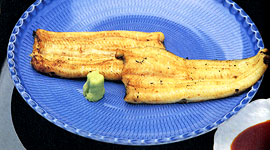 sited from "Irodori vol.23"
sited from "Irodori vol.23"
Where the eel to spawning is the Philippines off the coast, but it does not detail specific can. Hatched fry north, Hamamatsu from Kyushu, to reach the per Choshi, will continue up from the estuary to the river. In this area, whitebait fishing is done.
Whitebait fishing is lifting of the ban in December, it will be held until March. When this time has grown as the length five-five cm in. The amount that caught the whitebait has plummeted in the last few years, has continued for a while high. In poor catch enough of is said to be the worst this year, became the price of one kg (about five thousand fishes) is what million. Aquaculture eel should we fill the eggs, but for now, I have never such a story heard. In the ponds it does not seem Seiwa the conditions for spawning.
The I let go in aquaculture ponds Shirasu, if growing up in this size, fry and eat the food that was a powder of sardines as a raw material, it will become bigger and bigger.
The ship on Saturday Ushinohi must be released to the ponds is also in until around January 25th of the year at the latest. The whitebait to become adults in about half a year from being released into the pond, referred to as "Shinko". Due to increases in the early, will thin a little taste. Whitebait that has grown over the early winter from a little more slowly and early fall, the ride is fat than the summer of eel, interference may be, the taste is also the best. Called "Hineko" the whitebait grown over a little time.
And say eel might be the summer of the image is strong, but also in farming is also a natural, delicious is the most is through early winter from early fall.
Kashiwamochi(rice cake)
In Japan, there is a national holiday called "Children's Day". Celebrate eating auspicious Kashiwamochi and Chimaki (Zongzi). In the Keihan region make a Zongzi to first sex, you eat make a Kashiwamochi from the second year. The Zongzi There are round bamboo dumpling filled with red beans and miso to other Sasamaki of or conical triangle. Origin of Zongzi is, China Spring and Autumn Warring States ousted the Qu of the country of Chu of the era, mourn the was to drown oneself in the Miluo River, (there is also a theory that sister) Chu people put the rice in bamboo, walnut leaves of Satinwood , because threw tied with thread seems to dogma.
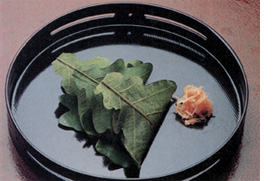 sited from "Irodori vol.36"
sited from "Irodori vol.36"
The sex cuisine 'Festival will be used is Zongzi sushi likened to Zongzi. Is said to cooking sushi of Kansai style, wrapped in three pieces of bamboo leaves to inspire the white fish and shrimp of tightening in the vinegar in vinegared rice that was ahead of the sweet taste, it is what was wrapped in Lee. Not a Zongzi but there is also a sushi that Sasamaki sushi.
Ayu, horse mackerel, garfish, small sea bream, which was wrapped in vinegar rice and striped bamboo and stripped himself a tightening in the vinegar, such as gizzard shad, also known as tweezers sushi from the fact that using a tweezers to pull out the small bones. Sasa is a material with excellent antiseptic and storage stability. Edo long-established Sasamaki tweezers sushi specialties are located in Kanda still Ochanomizu. Leaf sushi of persimmon with May of the young leaves, wrapped in leaves of persimmon together Sogigiri of Shiosaba and vinegared rice, is what was laid down a whole day and night to put the tub put the stone. It has also become a specialty of Nara Prefecture.
Today's multi-course menu to be lobster Gusokuni, sea bream helmet grilled, boiled helmet, arrow feather Atsumono, arrow feather lotus root, specifically conger eel, Tatetorizoku, bow burdock, such as streamers tofu, it is issued those of sex likened. Depending on the local attaches Shobuzake in HoriYoshi, sea bream and bonito, such as carp are used, there are still wide customs to enter the Shobuyu.
Speaking of Kashiwamochi, father of drunk can not buy even warrior doll in the first sex of our children, the way to the shopping holds the doll price uncle gave me in Megumin, meeting with colleagues, and got Ogo' generously, empty-handed in and go home, I remember story that was wrapped in to say that you treat the Kashiwamochi uncle futon.
For me who grew up in rural, Kashiwamochi is also a taste of the mother. I remember the appearance of the cheek Bal boyhood the Kashiwamochi while watching the carp streamer.
The phrase "eye to Aobayama Shiki Hatsugatsuo" (Sodo) is is what Edo of Hatsumonogui made the faith that want to eat the Hatsugatsuo also put the wife in quality, greet the other rainy season and too the May It will be on the season.
Nagori-takenoko(Bamboo Shoot)
Boil water in the kettle, go to digging bamboo shoots in the mountain behind. The countryside of the bride, was educated as a "throw it in the pot before the bamboo shoots also cry baby". In how quickly or boiled from digging, I taste of bamboo shoots is determined. It is a game of time to contest the one second a minute.
Season of bamboo shoots is a moment. Two to three days, will past the season in extremely say if one day. Soil is bamboo shoots issues a face cracked, the season when that extend to about the size of an adult hand.
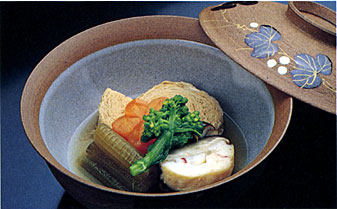 sited from "Irodori vol.02"
sited from "Irodori vol.02"
Then it will be the size of the double in one day. The relic to grow up to two half of hand. Is good most taste bamboo shoots of the remnant, but it will firmly slightly.
The bamboo shoots, there are three kinds chasing time. Initially greet the relic in May bamboo. The Mousouchiku are many, it refers to the bamboo and say bamboo shoots. The following is a Madake. And finally greet the season in June Hachiku. Production amount is less expensive is the most delicious.
Ibaraki production bamboo shoots is the best flavor, crunchy, to taste both. However, not to circulate only in fine dining and value is too high. Easy to go into the hands of the common people, Kagoshima, a thing of Shizuoka. Any bamboo shoots, at any time of bamboo shoots, is the principle to the accession unplug before you always cooking. The accession is acridity, acridity will bad taste. It remains of skin, (which may not be put cut without cutting also pike) whole, by the addition of red pepper and boiled about five hours in the water and put the rice-rinsing of rice. The next day put as it is overnight and exposed to water.
Eleven, December around, still referred to as the early digging bamboo shoots what was dug up the buried as much soil 30cm. A soft, unusual only of bamboo shoots, and lacking in the original taste, but you used to, such as Juzume of the New Year.
Running of bamboo shoots are young bamboo bowl, season of bamboo shoots is grilled, bamboo shoots of vestiges is the most delicious way to eat is tighten boiled. Grilled with salt is baked and stamped skewer as it is sprinkled with salt, it is a fish best sake and eat in ponzu. The boiled tighten, you put the buds over Katsuwo clause. Spicy of buds is you bring out the taste of bamboo shoots.
Edamame(Green soybeans)
"It's edamame when you drink a beer," said the more say reflexively, edamame is the beer and the chemistry is good food. Beer garden, etc., will be very surprised and teach the "soy is what grew up edamame" to young women. Edamame is I think we are not surprisingly known is that it is immature soybean.
Soybeans compared to other legumes, protein and fat is remarkably rich. 35% of the protein content of the whole, fat 19%, and the remainder is in the sugar, the water there is little. This nutrient-rich soy, to eat taken just before heat is edamame. It is called edamame because eat still attached to the branches(eda), but was also known as alias "Azemame".
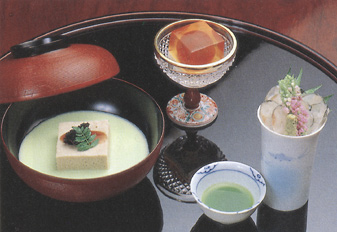 sited from "Irodori vol.04"
sited from "Irodori vol.04"
Originally planted soybean on the side of the ridge of the field. Main root of soybeans may also reach the earth 1m, put out a lot of branch roots, you can spherical nodules in the roots. The nodule occurred thing called rhizobia, this fungus is the nutrient source of soybeans stored the nitrogen in the air. Soybean is one of the world's food, to eat in the state of edamame is the only Japanese.
The origin of soybean is the Siberia of the Amur River basin. The first place to produce the edamame, which had as a luxury goods Tohoku, Kanto, did other regions, such as Niigata, have been nationally production at present. Probably because it became a much national favorite that Edamame has been fixed in Japan.
Among them, Shizuoka Prefecture Shimizu very thriving greenhouse cultivation of edamame in Komagoshi of, are shipped under the brand named "piece". This land is full received the light of the sun in a mild climate, it is blessed with the location conditions that well-drained sandy soil. And also be familiar with the greenhouse melon of technology, edamame cultivation was developed taking advantage of that tradition. Flowers bloom in one month from planting seedlings, fruit is harvested in two months. So - it would be able to cultivate year three to four times. By the way, the temperature at which this fruit is born is also fifteen degrees. Is to use the most care at the time of production, is a "stain", "color". Frost Improper temperature control is attached to the hair of the sheath you she can "stain". The color was also piled up quality improvement so as to be vivid green of "Sapporo green".
End out edamame of house cultivation of Shimizu, appeared things simultaneously it is now when it comes in July open field. This game is good for freshness. Proven edamame in Tokyo Tsukiji is, "Snow Maiden" of Saitama Prefecture Soka or Nitta, is such as Gunma Prefecture Numata of "Tengu (Nishikiaki)". "Jewel" of Tokushima Prefecture, in Osaka, is such as Takayama, Gifu Prefecture ones. Other, slow ship date, but not to circulate in great market, "Dada tea beans" in Shonai, Yamagata Prefecture, "Niigata tea beans" of Niigata Prefecture, Hyogo Prefecture Tamba, such as "black soy" is old-fashioned smell of and you can experience the rich edamame.
"I happen when Edamame is eaten in the summer" to we tend to associate with is, edamame has been established as a food of the summer. At present there is edamame frozen, but Is it possible to eat even the dead of winter, the real season is of a early fall. Rather than in September waxing gibbous moon of the lunar calendar has been and shall not, "beans moon" that of the waxing gibbous, that of edamame is referred to as a "moon beans", is late September It had been the most delicious. But this is a thing of the only ones open field, you can eat the already delicious edamame is in June thanks to the greenhouse cultivation as described above is now.
Fat edamame, such as a young woman of jeans, there is a youthful fresh elasticity. Beans you flew in the mouth and sandwich the salt boiled the edamame with a finger. And bitter beer. The couple feel the youth and life of astringency is one of the meal must not again in the summer of Japan.
Maguro(tuna)
Would not the tuna likes ethnic about the Japanese in the world. Recent young people do not eat too much fish even, tuna only is tolerance.
Among them, Japanese people love Toro. And came to Toro to eat to say is that after the war. At the time of the Japanese was the lack of fat. In modern times of satiation, we heard that no longer Toro is favored little by little.
Certainly, such as fat a lot of Toro, Gataku say that elegant food, previously thing you did not use in the restaurant. In the Kansai region of the restaurant even now, only white fish Speaking of build (designation of sashimi of Kansai), lean is about using the best fat is less bland joint (children of this tuna).
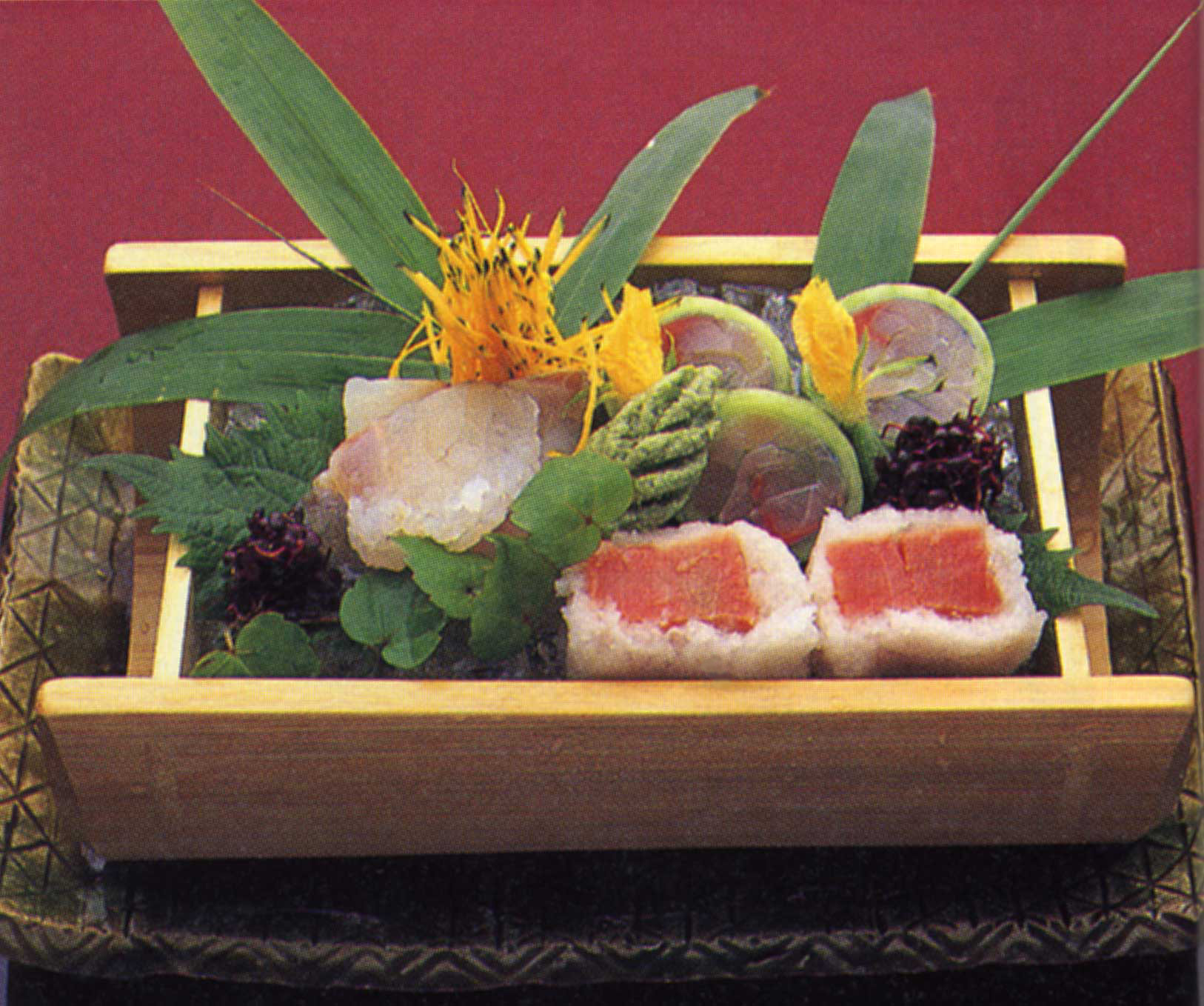 sited from "Irodori vol.13"
sited from "Irodori vol.13"
Toro had been eaten mainly as Negima (pot dish of chopped tuna and green onions). But it is such a large Toro had been discarded sell cheap, now Toro of this tuna is to be forty thousand yen per km away.
Tuna in order to answer to the favorite Japanese demand, tuna fishing vessels also will continue to fishing and to the world of fishing grounds, regardless of the season today. In the case of deep-sea tuna boat, once when fishing is one year from six months Akekure in operation, it is so continue Catching up to 80 percent of the tonnage of the ship.
Tuna was caught in the deep-sea is, flash frozen to below zero sixty degrees at sea (requires two days to freezing), it can carry up to Japan while maintaining the quality without compromising the flavor of the tuna. With this innovation, than refrigerated tuna that are caught off the coast of Hawaii in the market, towards the ocean of frozen tuna it is welcome, we expensive.
The tuna was caught in the waters, there is also a Taiwan tuna. Day at the end of work, because the return is carried by air, you not to be outdone in the freshness, but is seen bleeding on whether the order to be treated roughly tuna, it seems to reduce its value. Also in the tuna was caught in the same waters, Japan's waters tuna male, of Sanriku tuna. But catches have decreased, Boston tuna is famous in its outcome Tokyo Tsukiji market. Here also are transported by air, you will arrive at the Tsukiji remain fresh. Since the taste may be, to the price basis it is traded as quality goods to surpass the tuna of Sanriku. Therefore, Catching rolled in the United States of the Atlantic coast, it has become a shortage every year goods.
In any case, because profitable, the win incessantly is Kangaemono. Is a problem particularly are mixed a lot of juvenile fish in frozen tuna of deep-sea fishing. From the viewpoint of resource protection, which has become in recent years been actively said, it should capture only those who grew up to some extent, might be the day will come not eat really Otherwise, the favorite Toro.
That said, tuna irrespective of age or sex is the favorite food of the Japanese. You'll be able to continue much Catching the future. In recent years, (not a farming) tuna of Yo畁Eas an attempt to secure resources that began in Spain has great expectations. Of course, but will the Japanese have done, so as not to step on the yellowtail and the same rut (failure of the loss of flavor by food), I just pray nothing but. Tuna is troubled gone, we own that's because is.
Yamaimo(yam)
Yam eating as Tororo is also known as yam. Belonging to dioscoreaceae, but its kind is there seems to be about 600. Tropical and sub-tropical, it seems especially common in Central and South America.
Or eat as a side dish in Japan, but it is often the confectionery of raw materials, in the tropics are also staple food. To include starch as one of the main components, it is not useful enough as a staple food. Yam that is available in Japan, wild yam (wild yam), yam, there are three types of Daiimo (yam). Wild yam is native from ancient times in Japan, but has been used in edible and medicinal, is a different kind of a yam that has developed as a cultivated species.
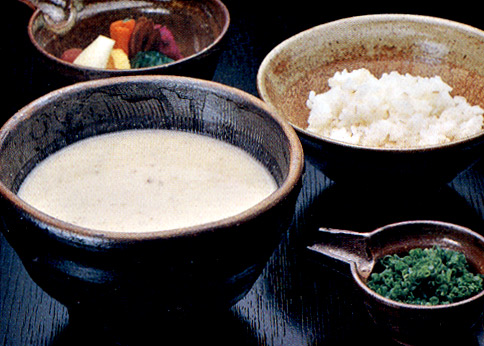 sited from "Irodori vol.20"
sited from "Irodori vol.20"
Yam is a native of China, is what was brought over from China to Japan. Old potatoes that cultivation was started in Muromachi era from the Asuka period. Chinese yam this fellow is differentiated, ginkgo potatoes, occur type, such as Yamatoimo, it has been around a lot.
It hits anniversary, but it is still the most delicious is in August yam. The spherical Yamatoimo became nodular is Tsukuneimo. White skin of Ise potatoes, black skin of Yamato potatoes, in Tamba potato is representative varieties, taste is a well-stickiness strong luxury goods, is in high demand in the Kansai in the center of Kyoto.
Yam is a cultivar of wild yam, is stickiness many moisture is low. Boiled and, mixed with plum meat chopped raw taking advantage of the goodness of the texture, but pickles may be. This dish is often around Saitama Prefecture. Pickles of Chinese yam has good texture, is nice to not find so deeply. This is an acquaintance of the cook specialties, have been also introduced "Oishinbo" foodie of the comic book. For those who visit his shop watching TV and magazines, Will had to offer. Even when is done now, and this pickle is provided at the end of the cooking course.
The main component of the yam kind is starch and mucilage. Was using the nature of this mucilage is "tororo". Grate carefully turn addressed the yams to the inside of the mortar. Than grated in rough grater I can not say yam of the palate. Or added to the broth in this yam, stretches lightly added to the eggs, but those strong viscous, it will remain strong sticky even stretched faint forever.
I don't know "barley to yam soup" (Mugitoro) the combination Who idea, but would be way of eating, which finds a pretty busy person. Once, there was a store that "Mugitoro" is eaten in the place leaving the Yaesu north exit of Tokyo Station. Wheat rice was the second helping of the Standing eating freedom shop. A friend is that "treat the rice", is waiting in the Tokyo Station, I went to the store. When the meal is try to finish, there was also that you have interest and I treat people of really cheap rice.
In general, since a fellow of the Chinese yam has less starch and mucilage, not very worthy in Tororo. Compared to this, ginkgo potatoes, fellow Yamatoimo have many mucilage, utility value as a yam is high for you. Work of the enzyme yam class is very strong, because it contains amylase, it has been said to be good for the digestion of starch. In addition, to change pale black in a short period of time and grate the yams is due to an enzyme called poly fail oxidase. Just peel the potatoes and apples, the same as change soon darker, this enzyme is to act as the contact with the air.
Yams class is from a long time ago, is said to be "Yamayaku" in Chinese medicine, but has been used as a nourishing tonic, is not is uncertain extent of its potency. Recently, it is also said to be effective in cancer prevention in mucilage.














